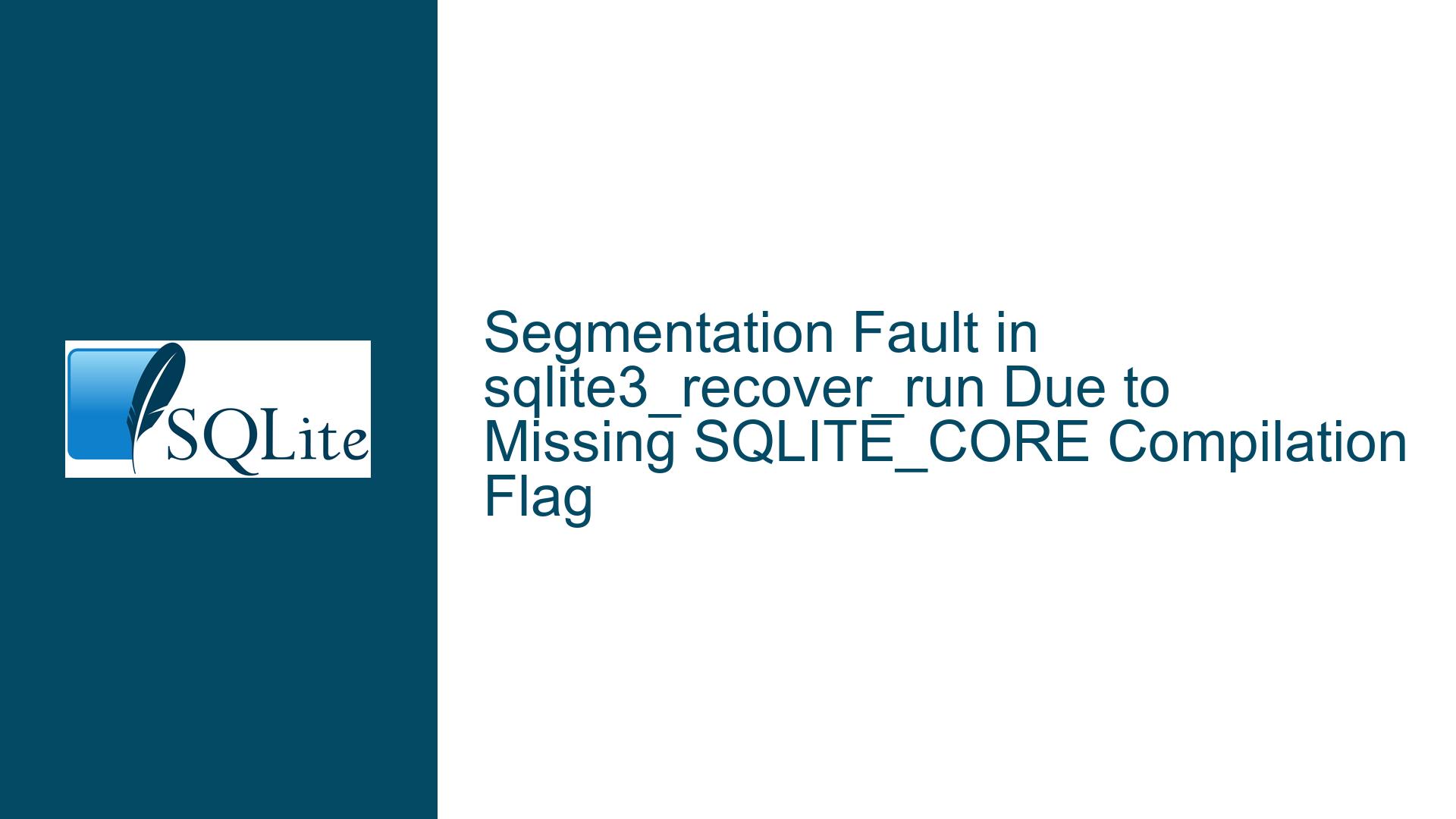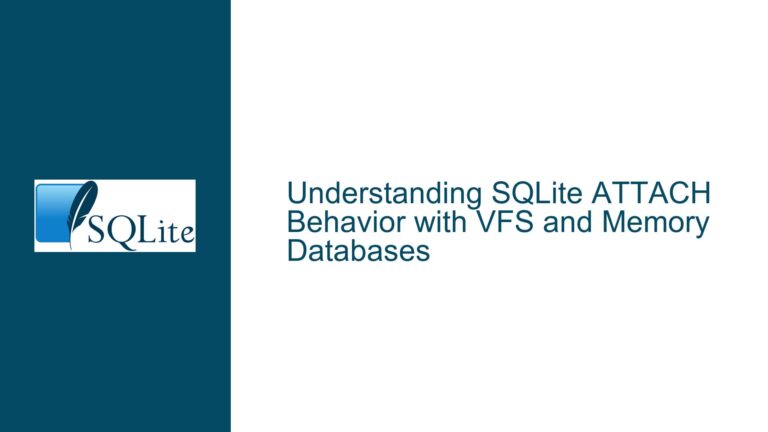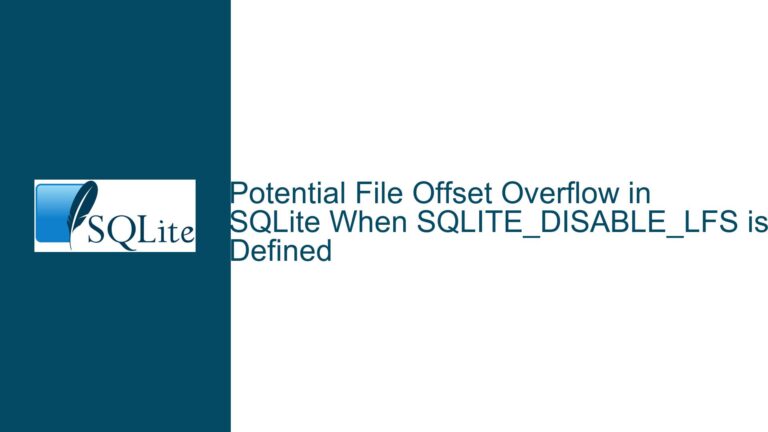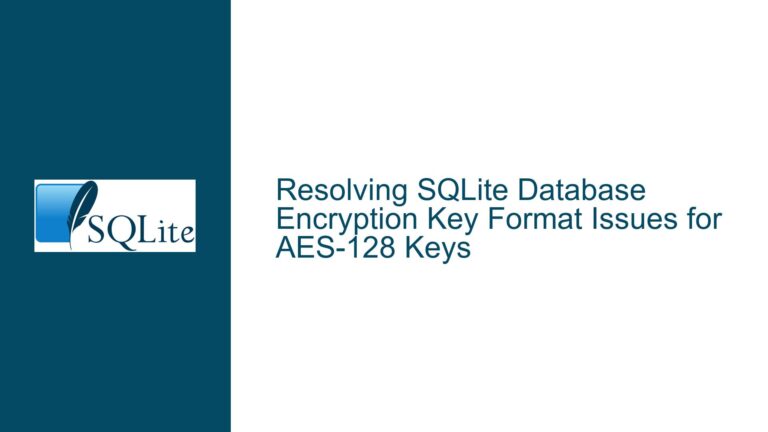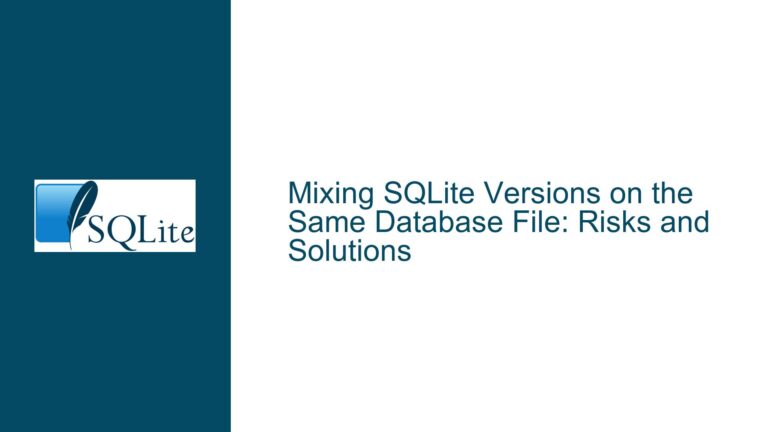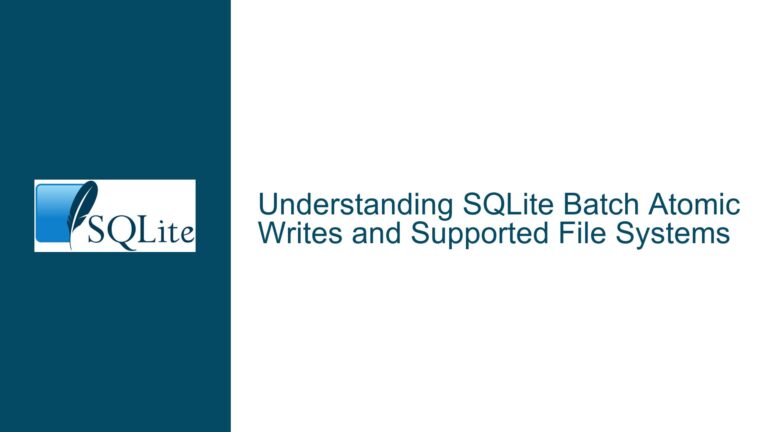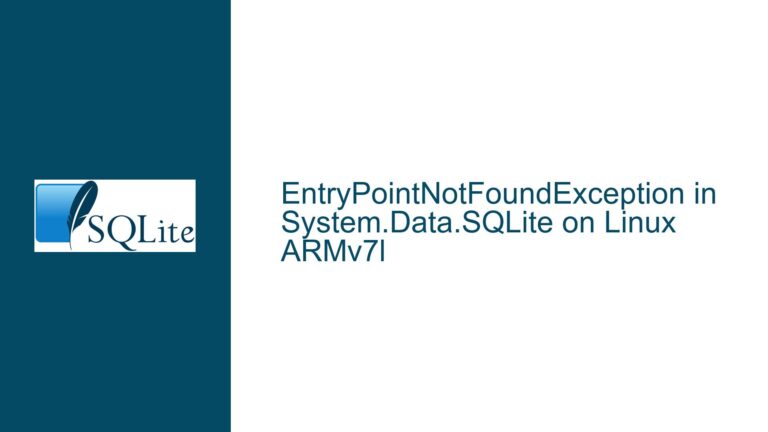Segmentation Fault in sqlite3_recover_run Due to Missing SQLITE_CORE Compilation Flag
Incomplete Initialization of SQLite Internal APIs During Recovery Module Registration
Root Cause: Absence of SQLITE_CORE Compilation Directive in Custom Build Configuration
The segmentation fault encountered when executing sqlite3_recover_run() stems from improper initialization of SQLite’s internal APIs required by the sqlite_dbdata virtual table module. This module is a critical dependency of the SQLite Recovery Extension (sqlite3recover), which facilitates database reconstruction from corrupted files. The fault manifests during registration of the sqlite_dbdata module via sqlite3_create_module(), specifically when the application is compiled without defining the SQLITE_CORE macro.
SQLite employs a dual-mode compilation architecture:
- Core Library Mode (
SQLITE_COREdefined): Exposes internal APIs and data structures required by built-in virtual tables and extensions - Extension Mode (default): Restricts access to internal symbols for stability and encapsulation
The Recovery Extension’s dbdata component requires direct access to low-level b-tree and pager interfaces that are only available in Core Library Mode. When compiled without SQLITE_CORE, these symbols remain undefined, causing the module registration process to dereference invalid function pointers. This results in a segmentation fault at dbdata.c:931 during the sqlite3_create_module() call.
Critical Failure Modes in SQLite Extension Integration
Undefined Internal API Linkage
The dbdata virtual table implementation relies on non-public SQLite interfaces like:
sqlite3BtreeCursor()sqlite3BtreeNext()sqlite3PagerGetData()
These symbols are excluded from the SQLite amalgamation’s public symbol table unless SQLITE_CORE is explicitly defined. Compilation without this flag creates unresolved references that manifest as null pointers during runtime module initialization.
Improper Build Flag Sequencing
Mismatched compile-time definitions between the SQLite core and extensions generate ABI inconsistencies. The amalgamation (sqlite3.c) and recovery modules (dbdata.c, sqlite3recover.c) must share identical configuration macros. Omitting SQLITE_CORE from the compiler command line while enabling SQLITE_ENABLE_DBPAGE_VTAB creates a hazardous hybrid configuration where:
- The core library assumes extension-safe symbol visibility
- Recovery modules expect full internal API access
This dichotomy destabilizes virtual table constructor chains, as evidenced by the failed sqlite3DbdataRegister() call in the stack trace.
Resource Ownership Conflicts in Multi-Module Initialization
The recovery process initiates multiple interdependent components:
sqlite3_recover_init()establishes recovery contextdbdatamodule registration viasqlite3DbdataRegister()dbpagevirtual table activation (implied bySQLITE_ENABLE_DBPAGE_VTAB)
Without SQLITE_CORE, these components compete for initialization order priority while lacking proper API version handshakes. The segmentation fault occurs when the dbdata module attempts to register itself using SQLite APIs that haven’t been properly initialized for internal extension consumption.
Comprehensive Resolution Strategy for SQLITE_CORE-Related Faults
Step 1: Enforce Core Library Compilation Semantics
Modify the build command to include -DSQLITE_CORE, ensuring internal API availability:
gcc -std=c11 -DSQLITE_CORE -DSQLITE_ENABLE_DBPAGE_VTAB \
-Isqlite-amalgamation-3410200 -Isqlite-src-3410200/ext/recover \
sqlite-amalgamation-3410200/sqlite3.c \
sqlite-src-3410200/ext/recover/dbdata.c \
sqlite-src-3410200/ext/recover/sqlite3recover.c \
main.c -o recoverdb -g -pthread -ldl
This flag:
- Exposes internal symbol tables to extension modules
- Aligns memory management strategies between core and extensions
- Enables virtual table constructor verification
Step 2: Validate Error Handling in Recovery Workflow
The original code misinterprets return values from recovery APIs:
// Incorrect check (assert() on truthy value)
assert(sqlite3_recover_run(recovered));
// Correct approach - verify SQLITE_OK return code
int rc = sqlite3_recover_run(recovered);
if(rc != SQLITE_OK) {
// Handle error via sqlite3_recover_errcode()/errmsg()
}
Update error handling to:
- Check
sqlite3_recover_run()forSQLITE_OK - Inspect
sqlite3_recover_errcode()after failed operations - Retrieve diagnostic messages with
sqlite3_recover_errmsg()
Step 3: Enforce Strict Symbol Consistency Across Compilation Units
Audit all compiler flags for macro conflicts:
- Remove
-DSQLITE_TEMP_STORE=3unless required for specific storage behavior - Ensure
-DSQLITE_ENABLE_DBPAGE_VTABand-DSQLITE_COREappear before any include paths - Verify include directory order prioritizes amalgamation headers
Rebuild with clean intermediate artifacts:
rm -f recoverdb *.o
gcc -DSQLITE_CORE ... [full flags]
Step 4: Implement Module Initialization Guards
Add runtime checks to prevent duplicate module registration:
sqlite3_recover *recovered = sqlite3_recover_init(...);
if(recovered == NULL) {
// Handle allocation failure
}
// Check for existing dbdata module before execution
if(sqlite3_find_module(original, "sqlite_dbdata") == NULL) {
// Manual registration fallback
int rc = sqlite3_dbdata_init(original, NULL, NULL);
if(rc != SQLITE_OK) abort();
}
This compensates for edge cases where automatic module initialization fails despite correct compilation flags.
Step 5: Profile Memory Access Patterns During Module Registration
Instrument the sqlite3DbdataRegister() function with debug prints:
int sqlite3DbdataRegister(sqlite3 *db){
fprintf(stderr, "Registering dbdata module on %p\n", (void*)db);
fflush(stderr);
int rc = sqlite3_create_module(db, "sqlite_dbdata", &dbdata_module, 0);
fprintf(stderr, "create_module returned %d\n", rc);
return rc;
}
Analyze output to confirm:
- Single initialization call per database handle
- Valid
dbpointer address - Non-zero return codes indicating SQLITE_OK (0)
Step 6: Cross-Validate Against Known Working Configurations
Compare the custom build against SQLite shell’s .recover implementation:
- Download prebuilt
sqlite3shell binary - Execute
.recoveron the target database - Dump build info via
sqlite3_exec()withPRAGMA compile_options;
Reconcile compiler flags and macros between the shell’s configuration and the custom application. Implement any discrepancies (e.g., additional -DSQLITE_ENABLE_ flags) in the build process.
Step 7: Implement Thread Sanitization for Concurrency Faults
Although not indicated in the original report, add thread safety validation:
sqlite3_config(SQLITE_CONFIG_SERIALIZED);
sqlite3_initialize();
Recompile with -fsanitize=thread and execute under controlled conditions to detect:
- Race conditions in module registration
- Improper mutex handling within recovery extensions
- Concurrent access to the
originaldatabase handle
Step 8: Audit SQLite Version Compatibility Matrix
Confirm that:
- Amalgamation version (3410200) matches recovery extension sources
- All components were downloaded from identical snapshot timestamps
- No partial updates or mixed-version includes exist
Mismatched versions between sqlite3.c and sqlite3recover.c can create subtle ABI mismatches that only manifest during internal API calls.
Step 9: Deploy Static Analysis for Symbol Visibility
Utilize nm or objdump to audit compiled binaries:
nm -gC recoverdb | grep sqlite3BtreeCursor
Verify that critical internal symbols appear as defined (T) in the symbol table when SQLITE_CORE is active, versus undefined (U) in faulty builds.
Step 10: Establish Continuous Integration Safety Nets
Implement automated build validation:
- Compile test case with/without
-DSQLITE_CORE - Execute both binaries on sample corrupted databases
- Verify segmentation fault absence and recovery success
Integrate into CI/CD pipelines to prevent regression during SQLite version upgrades.
Architectural Implications and Long-Term Mitigation
The segmentation fault arises from SQLite’s deliberate partitioning of internal/external APIs. Developers integrating advanced extensions must recognize that:
- Many SQLite extensions exist in a "trusted" domain requiring core compilation semantics
- Hybrid builds (partial
SQLITE_COREactivation) create unpredictable runtime conditions - The
sqlite3recovermodule occupies a special position in the extension ecosystem, demanding deeper system integration than typical virtual tables
Future-proofing strategies include:
- Maintaining separate build profiles for core-integrated components vs. pure extensions
- Implementing compile-time assertion checks for critical macros
#ifndef SQLITE_CORE
# error "Recovery extensions require SQLITE_CORE compilation flag"
#endif
- Adopting SQLite’s own
Makefileconventions when bundling non-amalgamation components
By anchoring the build environment to SQLITE_CORE and rigorously validating extension initialization sequences, developers can safely harness SQLite’s recovery capabilities while avoiding destabilizing memory access patterns.
